Al-Taawoun is currently ranked second in the Saudi Pro League, after Al-Hilal, who is in first place. Both teams have achieved 13 points from 5 matches. However, the goal difference is 9 in favour of Al-Hilal and 7 in favour of Al-Taawoun.
It looks strange that Al-Taawoun is above big teams like Al-Ittihad, Alhilal and Al-Nasr, whom Altaawoon won 2-0, but their excellent set-pieces have a massive part in this rank.
Al-Taawoun is the team that has scored the most goals from corner kicks in the Saudi Pro League, with a total of 5 goals in just five matches. It may be a surprise that the team in second place for most goals scored from corner kicks in the Saudi Pro League is Al-Nassr, with only one goal with Al-Ittihad, Al Ettifaq, Dhamk and Al Akhdoud.
Al-Ittihad and Al-Nassr have the strongest attacking line in the Saudi Pro League, with each team scoring 15 goals. However, each of them has scored only one goal from corner kicks. On the other hand, Al-Taawoun has scored five goals from a total of nine goals, which is a very high percentage of around 55%. This is despite their attack being ranked sixth with only nine goals scored. This indicates their heavy reliance on corner kicks.
In this tactical analysis, we will explain the tactics of Al-Taawoun in attacking corners and how set-piece analysis affects their performance and position in the Saudi Pro League.
Short corners
Al-Taawoun usually use short corners once or more at any match, and they have the flexibility to deal with the opponent’s defensive scheme. Let’s start with the first way they use short corners, which is achieving numerical superiority.
In the first photo, it is clear that they use a short-option player and two players on the edge of the box in the rebound zone to be four in total, with the taker, as shown in black numbers. They attack the box with five players, leaving a player at the back out of the shot. Al Fateh defend with two players who defend in zonal marking, in black circles, five players inside the box who defend in man-marking and three players, highlighted in green numbers; one defends the short-option attacker and two on the rebound zone.
In the second photo, when the taker raises his hand, an attacker runs to the near post to fix the zonal defender, in orange, who should help the short-option defender in case the corner is played shortly to prevent a 2v2 situation.
In the third photo, the 2v1 situation is clear. Hence, the taker passes the ball to the short-option attacker, then moves in green, having ample space to get the second pass to cross the ball from a nearer space while the two attackers on the rebound zon fix the two defenders in red arrows. Still, the short-option attacker chooses to dribble alone, and then the zonal defender and the rebound player near the ball go to face him, as shown in the fourth photo.
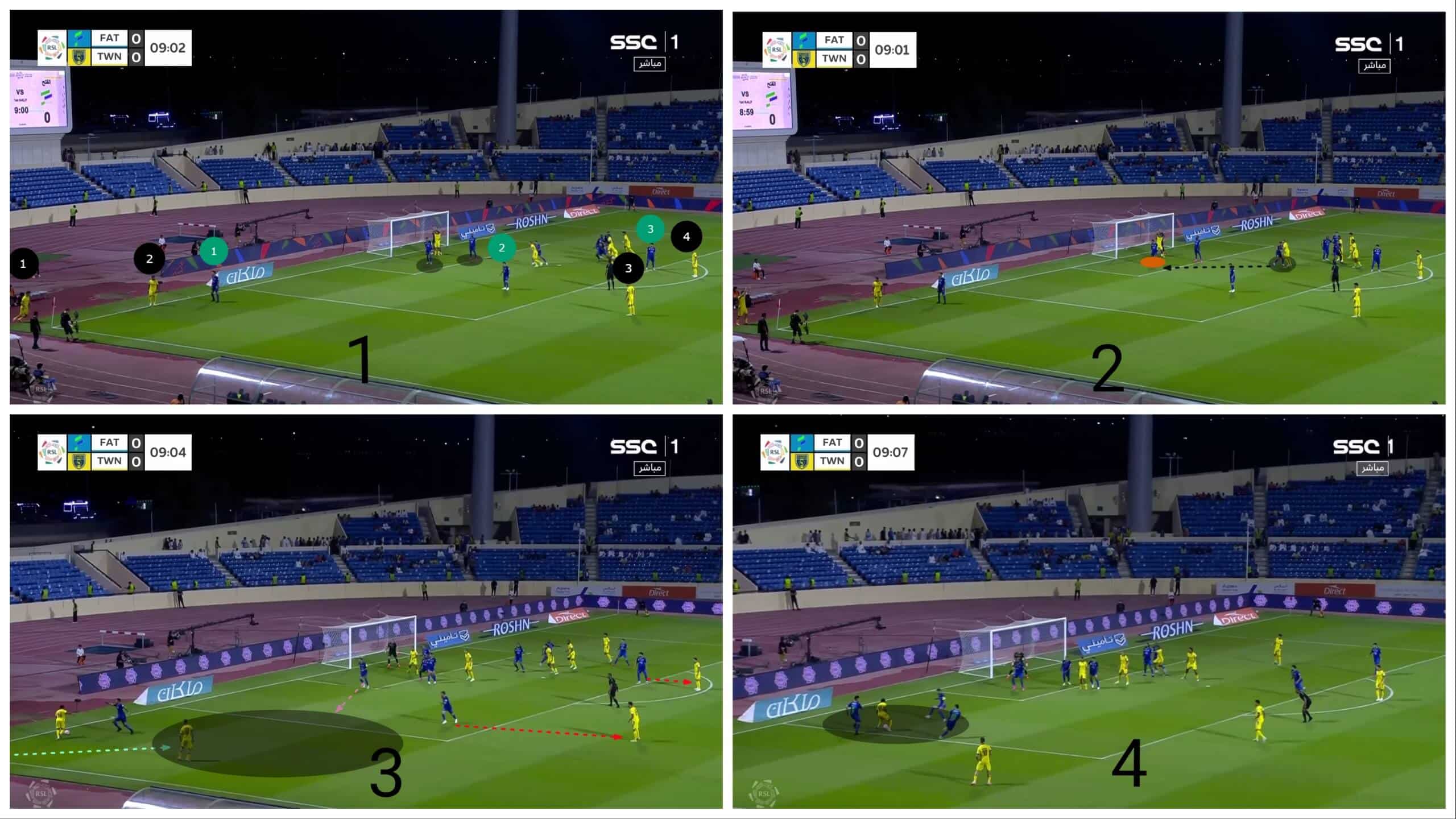
After that, in the same match, Al Fateh decided to dispense with a man marker to use him as a second short-option defender, in the first photo in orange, to make the situation a 4v4 situation, so there is an attacker without marking inside the box, in orange, so the defender, in pink shouts out asking the defender number four to mark that free attacker.
In the second photo, he gets back to mark the free attacker, leaving only one defender in the rebound player against two attackers, as shown in the third photo, so Al-Taawoun have no problem because they are flexible having the ideas to do according to the situation. Hence, the taker crosses the ball directly to the second attacker in the rebound zone, in orange in the fourth photo.
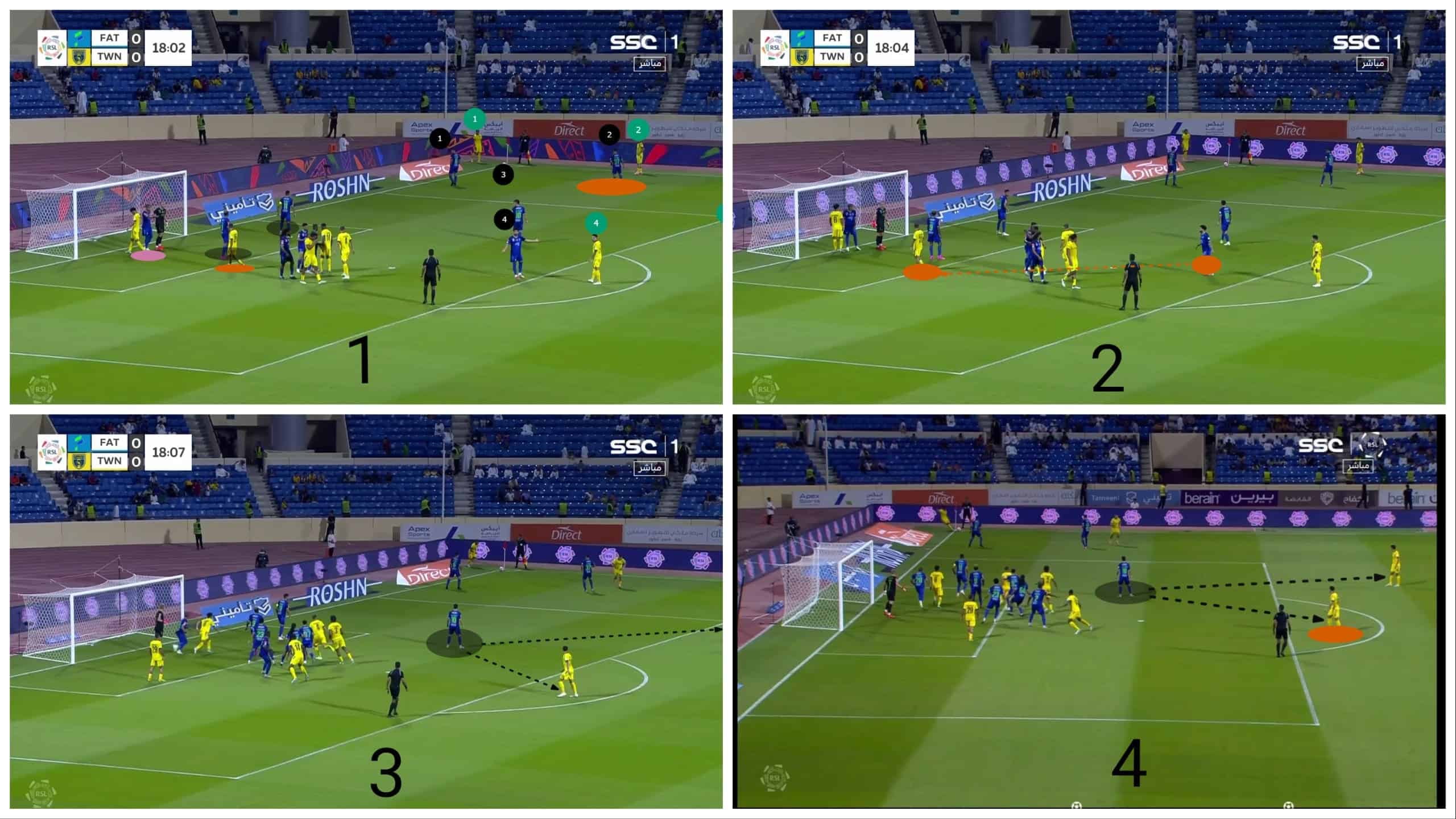
The plan works, but the shot gets to a goal kick, as shown in the following two photos.
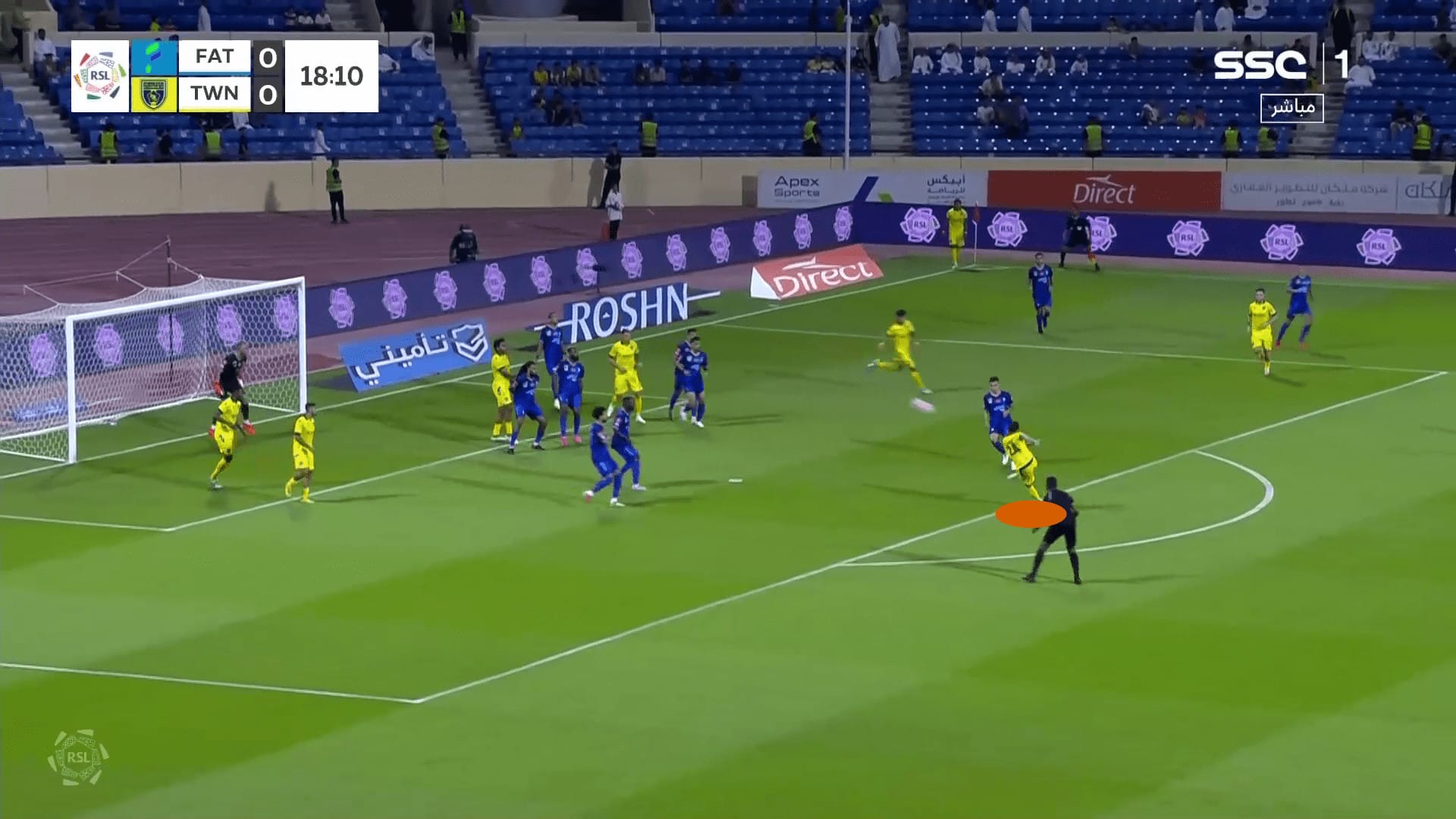
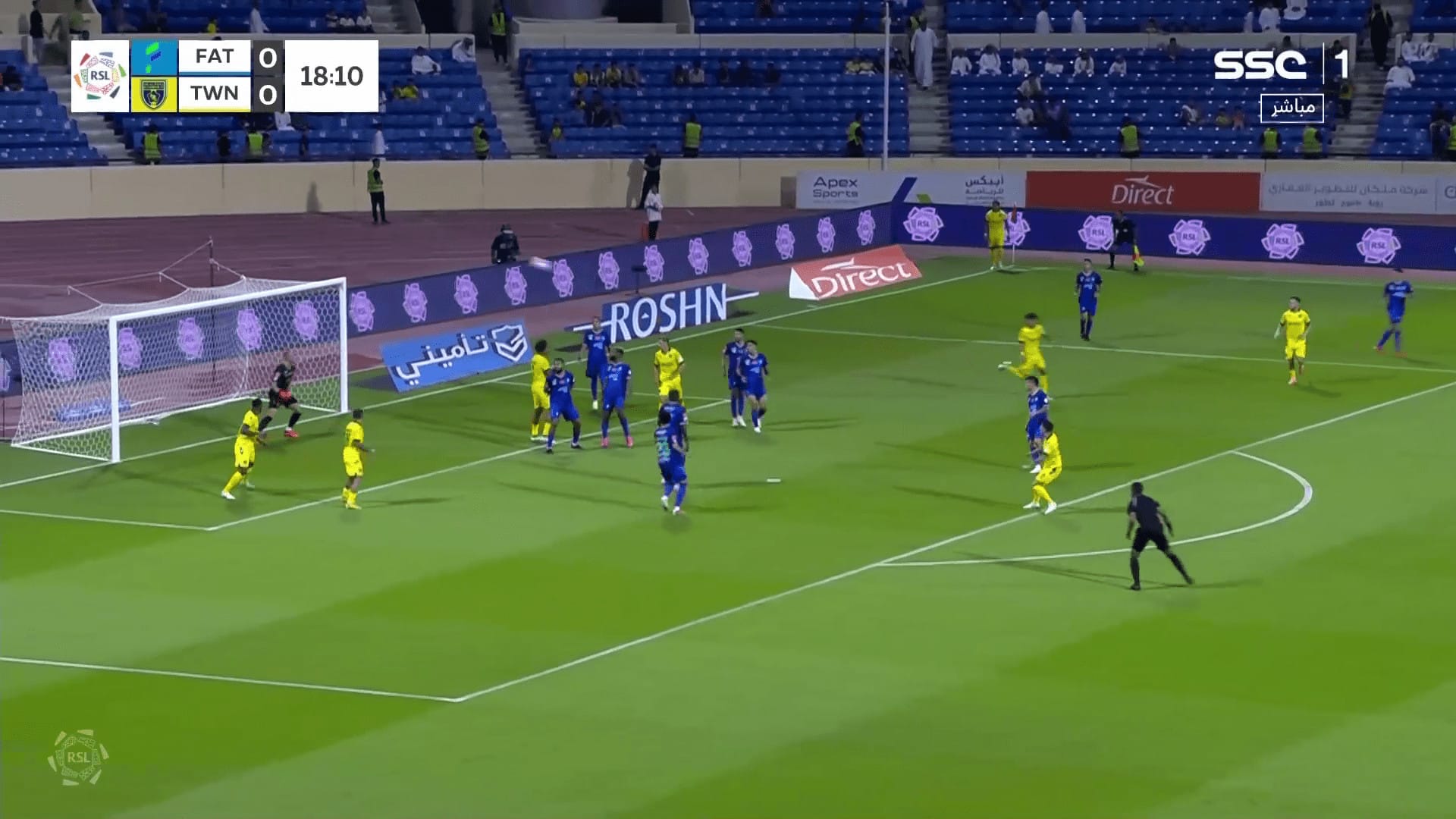
Al-Nassr had the solution to this problem, putting only one player to face the short corner at first, but his body position closes the direct pass to the rebound zone, in green in the first photo, but when the pass is played, the first zonal defender, in orange, goes forward to help him and a blue player in the rebound zone, standing in a middle distance to close the direct pass.
In the second photo, the 3v4 situation is clear, but they leave the farthest rebound attacker, in pink, which is considered safer for Al-Nassr because defenders in the box have time to face him when the ball is passed to him.
Against Al-Wehda, Al-Taawoun gets a counter idea against this defensive behaviour. The taker can’t pass the ball directly to the second rebound attacker. Still, when he plays a quick double pass with the short option attacker, he can play a through pass to him with the help of the first rebound attacker, who moves closer to drag the rebound defender, as shown in the third and fourth photos.
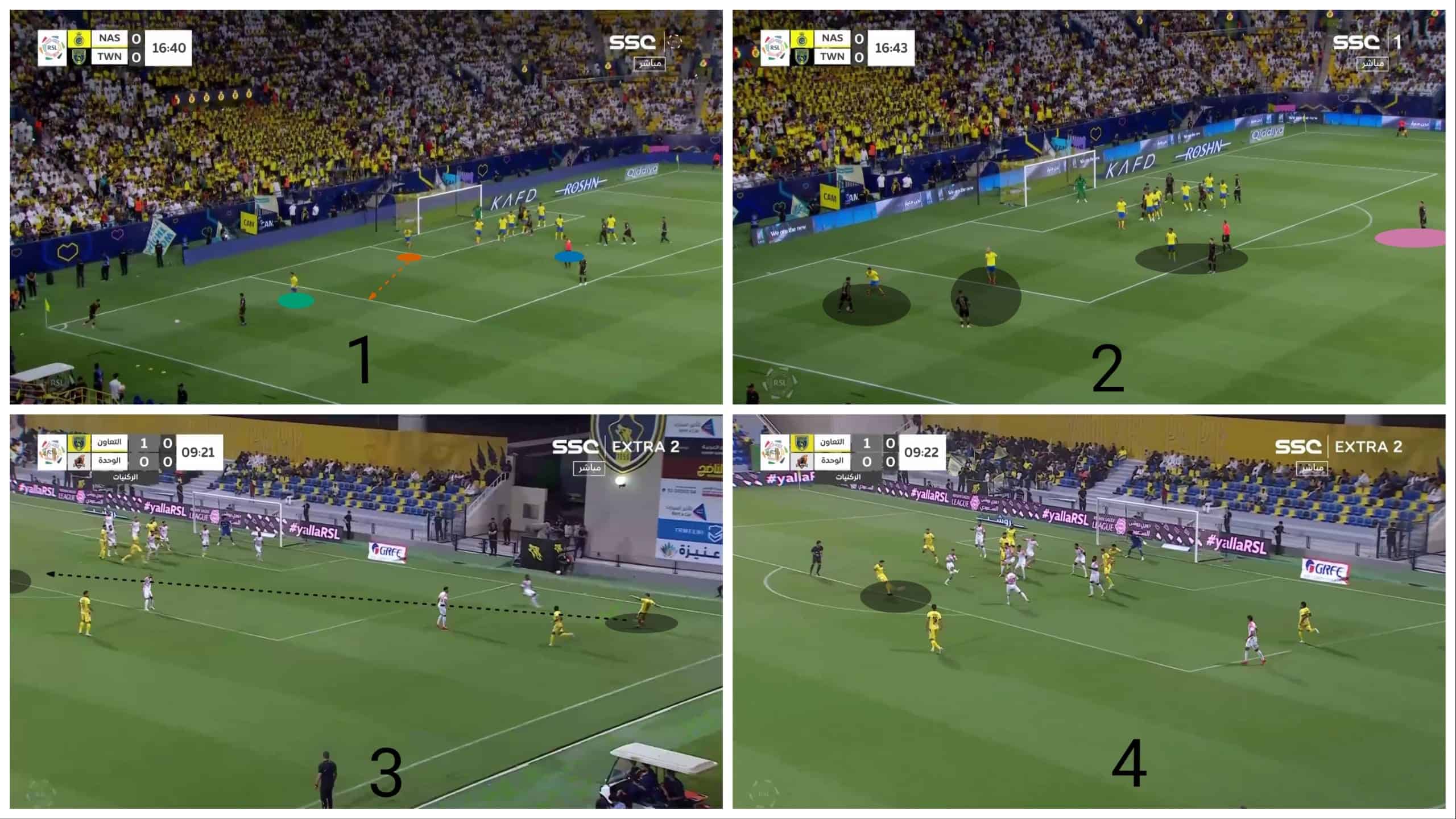
The result is a goal, as shown below.
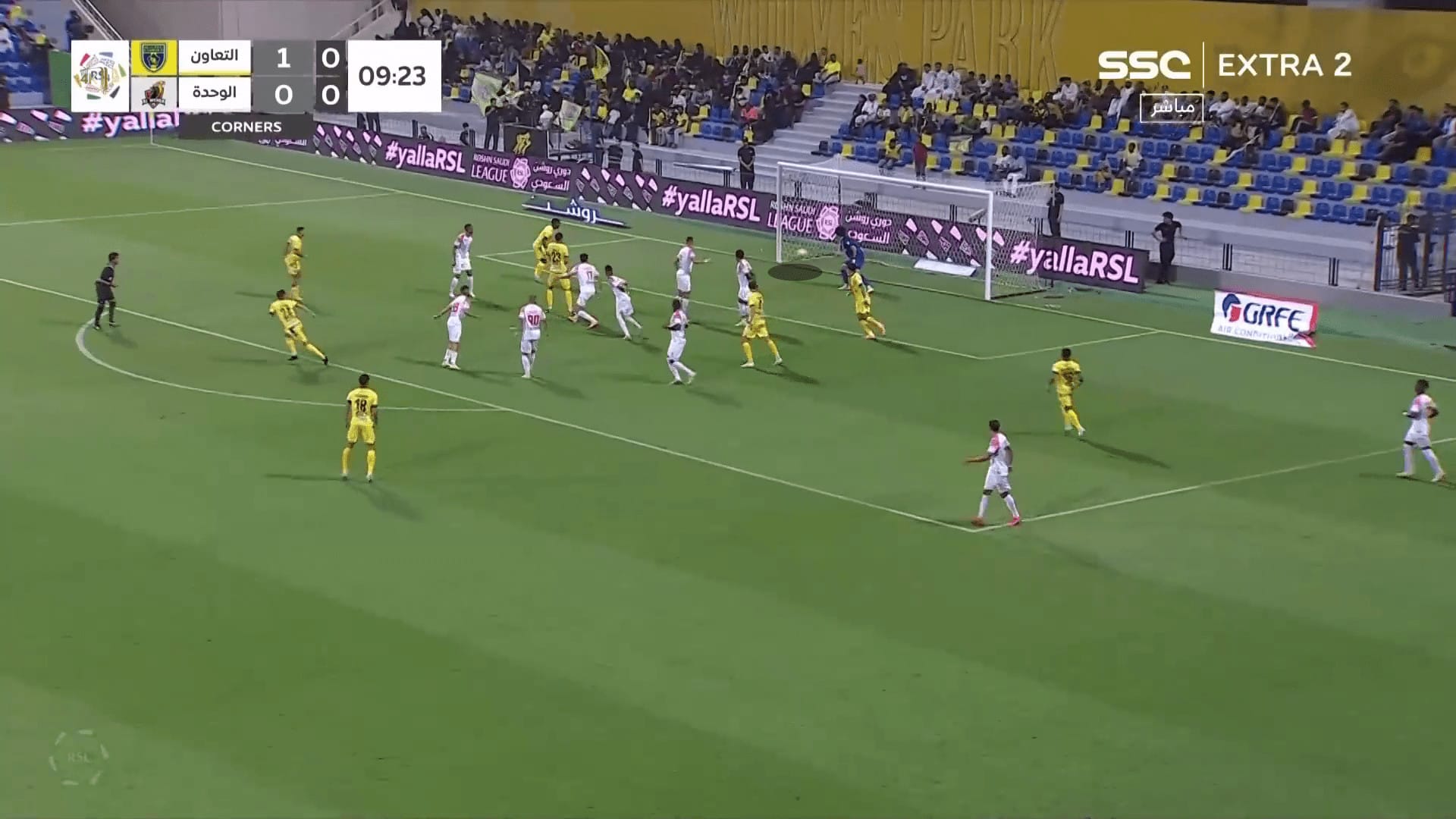
They have another idea in short corners, which depends on the difficulty the last zonal defender faces against the cross who is played after the short pass because the defensive line pushes up, so it is difficult for him to follow the ball in the air, the line and the attacker behind him in his blind side which is called an orientation problem.
The first photo shows a 3v3 situation, so they rely on the cross to the far post to the orange attacker, who starts at a position in which the last defender can see him. Still, after the cross is played, he moves behind the last zonal defender, in black, in the second photo, and it is clear that the defender has an orientation problem. Hence, the attacker gets the ball from his blind side, as shown in the third photo, and the result is a goal, as shown in the fourth photo.
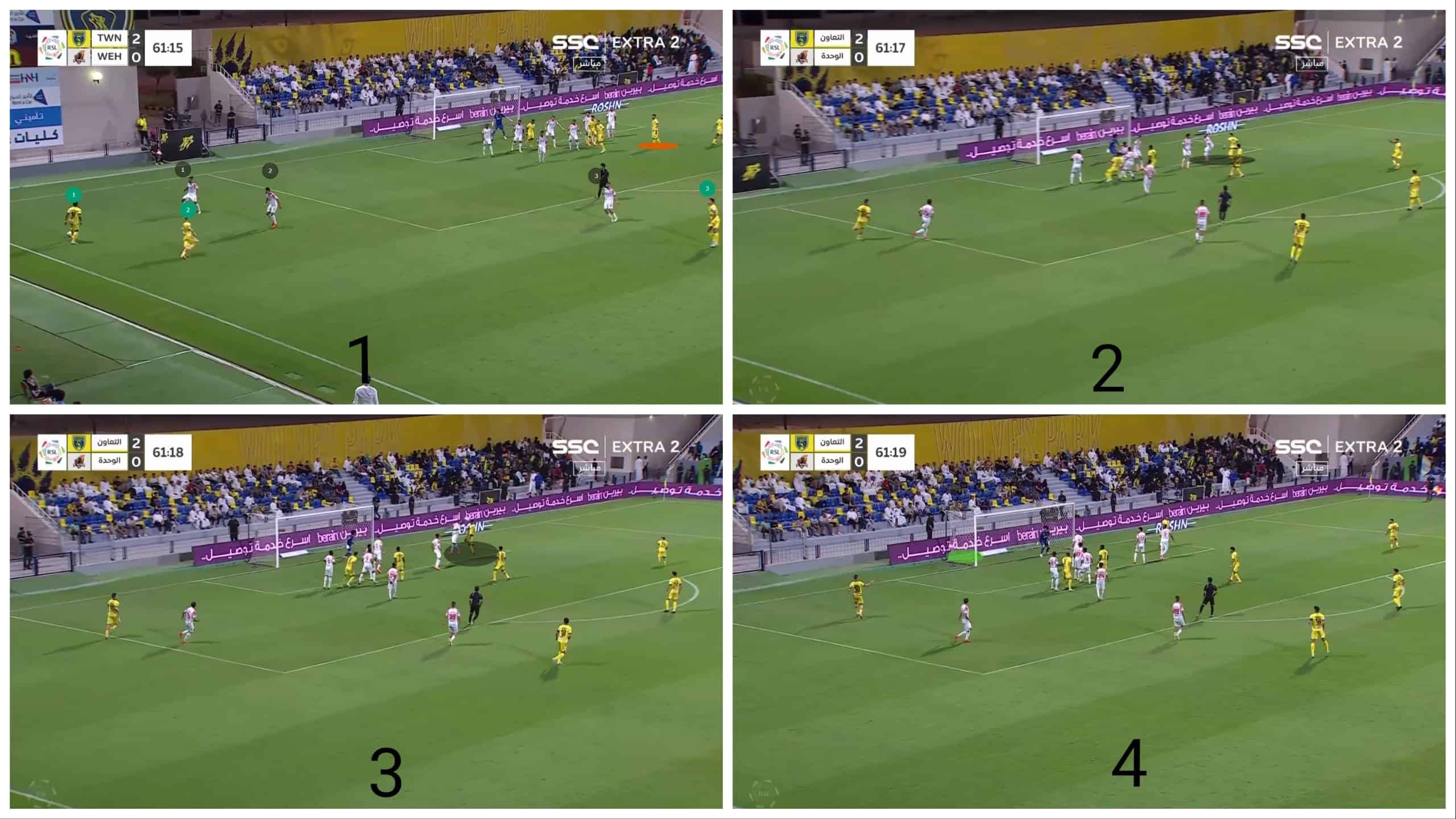
An attacker’s initial position with the goalkeeper
They also use an attacker to block the goal first, then drop back to get the cross, especially against teams who neglect to assign a marker to the attacker near the goal, prioritising the attackers in front of the zone line.
In the first photo, Al-Nassr is defended by zonal defenders, in green, in the first zonal line, including the near-post defender, standing on the edge of the six-yard because the cross from a left-footed player will be an out-swinging cross, and this gives the orange attacker, who sticks with the goal, the space to move back receiving the cross later. They also have three man markers in the black circles, so we have two orange players free from man-marking.
In the second photo, the targeted area is hatched in black while there are two targeted players: the orange player who was with the goalkeeper, then drops without marking and the blue player, but let’s see how.
The player, in black, moves to the near post, dragging his marker away from the targeted zone while the player stays on the edge of the box with his marker. In front of the line, the first free orange player blocks the third zonal player, preventing him from getting back to the targeted zone, and the blue player runs to the targeted zone with the second free orange player in front of the goalkeeper.
In the third photo, Sadio Mané leaves his marker in blue without even annoying him. At the same time, the block we have mentioned is apparent in orange, so there are two available attackers ready to get the ball, and the result is a goal, as shown in the fourth photo.
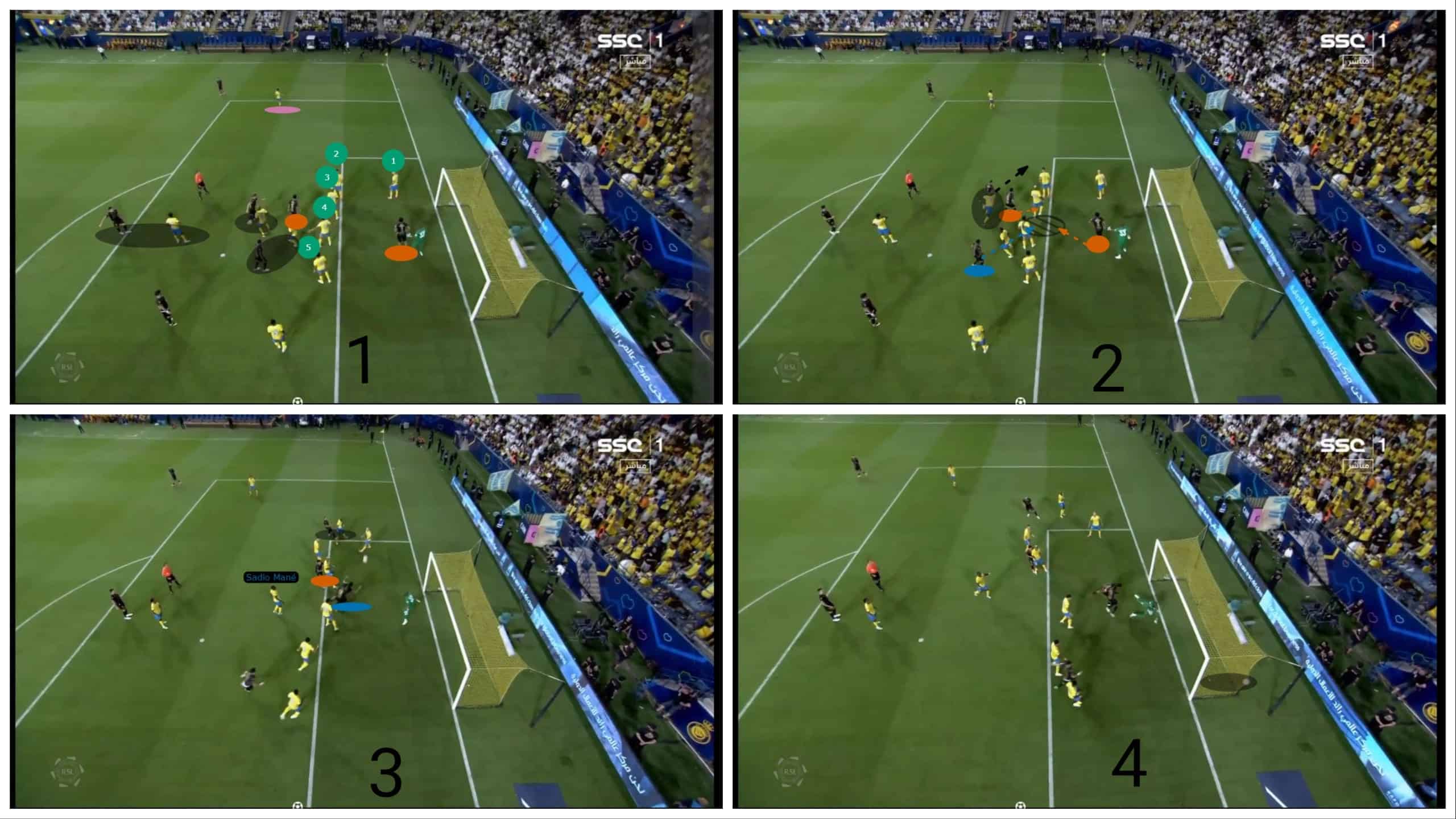
Mismatch on the near post
Al-Taawoun also have an idea to make the best use of Andrei Girotto’s good ability in aerial duels by moving to the near post and winning the first touch from his marker, who usually can’t deal with Andrei Girotto’s ability in aerial duels, which is called a mismatch, especially when he runs from the middle to get the first touch on the near post.
In the first photo, Al-Wehda defend with five zonal players in the zonal line, numbered in black, two man markers in green, and three players for the short and rebound zone, in orange. In the second photo, Andrei Girotto moves from the middle to the area in front of the near post, but why this area became empty should be mentioned.
In the third photo in a previous corner, there is a player in that area who has duties to push up after the short pass, but Al-Taawoun’s much and valuable use of short corners forces Al-Wehda to ask him to go forward from the beginning, and this is another benefit of Al-Taawoun’s use of short corners which is getting the opponent confused like a game of chess.
Going back to our case in the fourth photo, the orange attacker starts in front of the last zonal defender; then, he goes behind him to the far post when Andrei Girotto touches the ball.
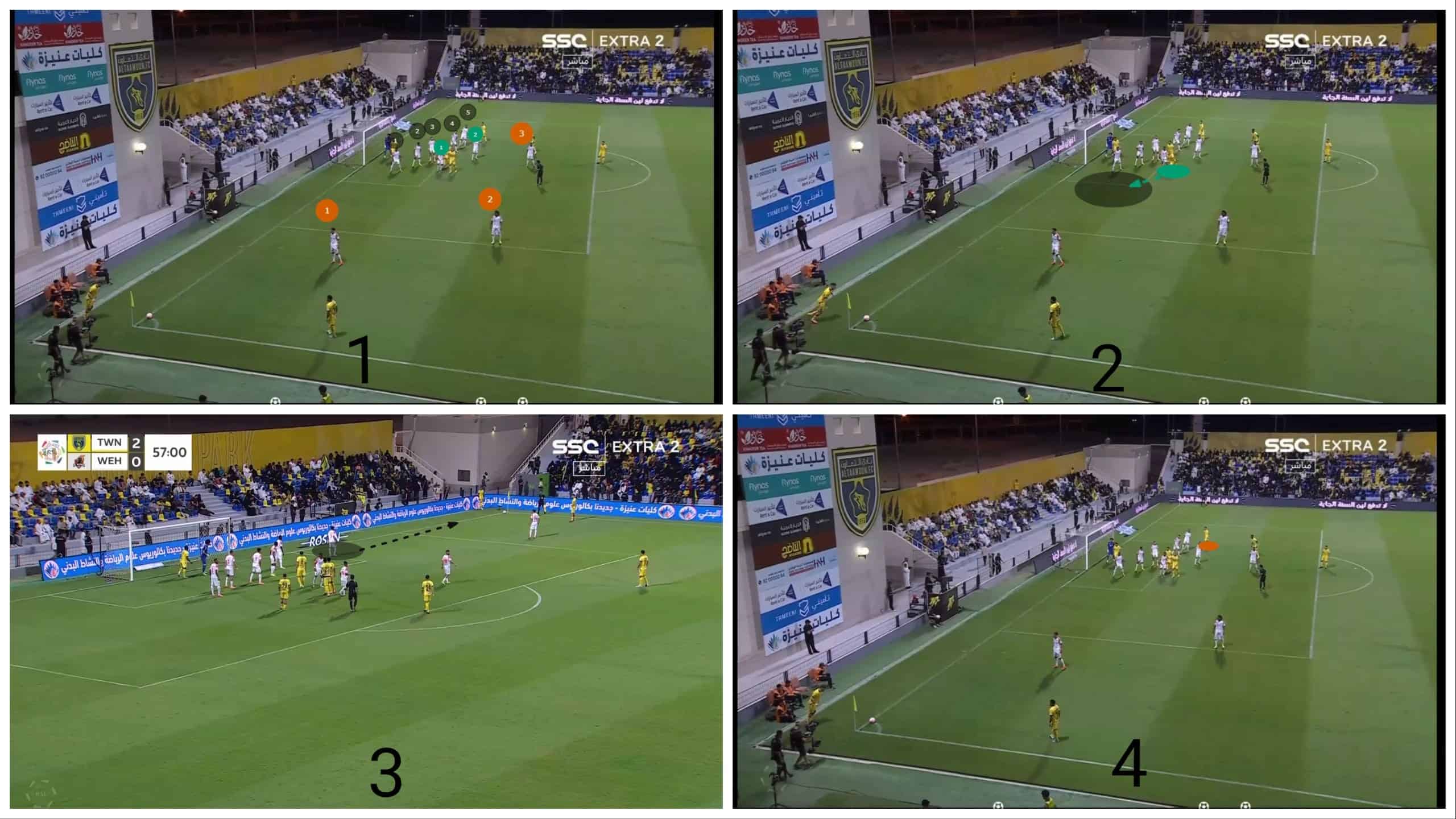
Andrei Girotto wins the ball while the other orange attacker moves behind the last zonal defender to get the head flick, scoring a goal, as shown in the photos below.
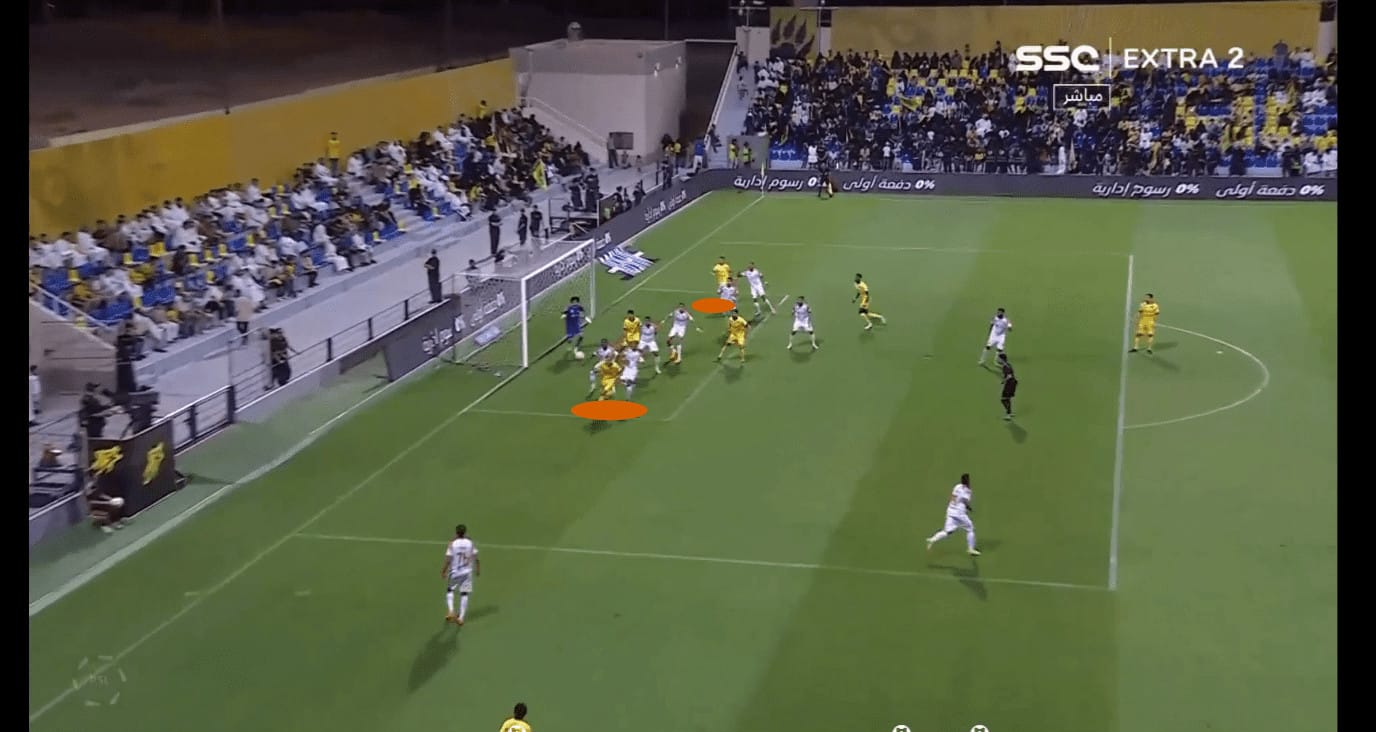
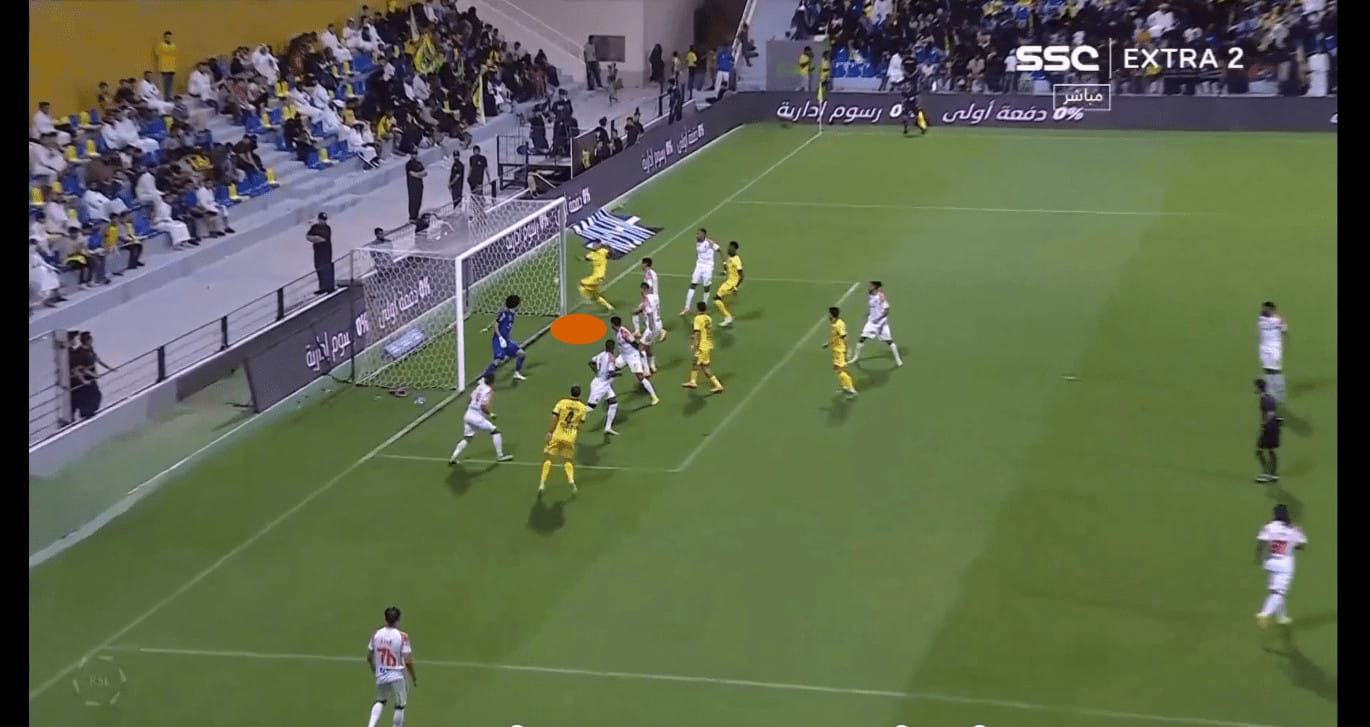
Conclusion
This analysis has illustrated Al-Taawoun’s tactics in attacking set pieces, particularly corners. It has also highlighted how they have become the team to score maximum goals by corner kicks in the Saudi Pro League and how this has affected their position in the league.
We have explained their heavy reliance on short corners and their flexibility in changing their plans based on the opponent’s position. We have also highlighted their dependence on the striker who stands in front of the goalkeeper and their preference to use mismatch on the near post.

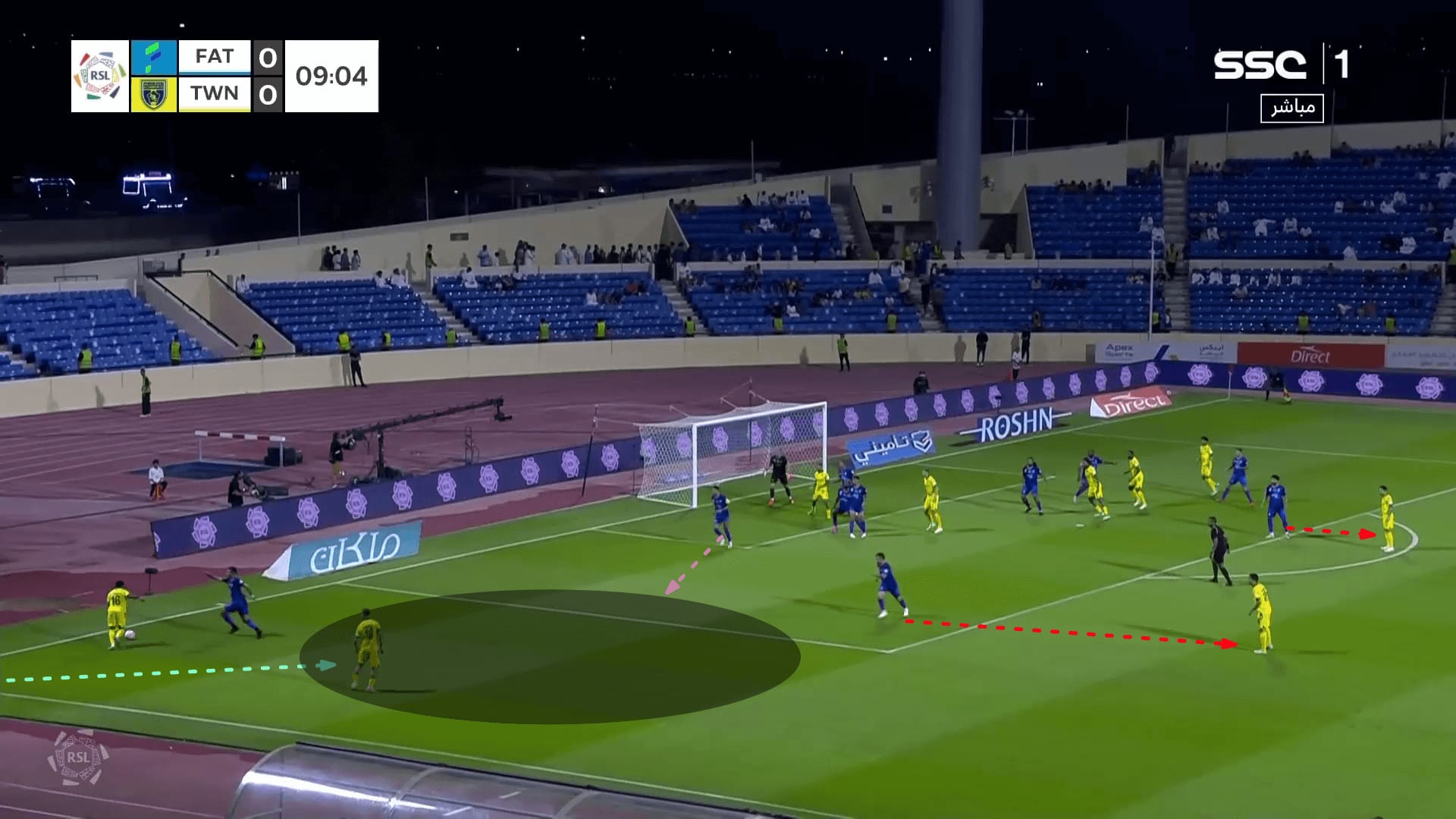




Comments